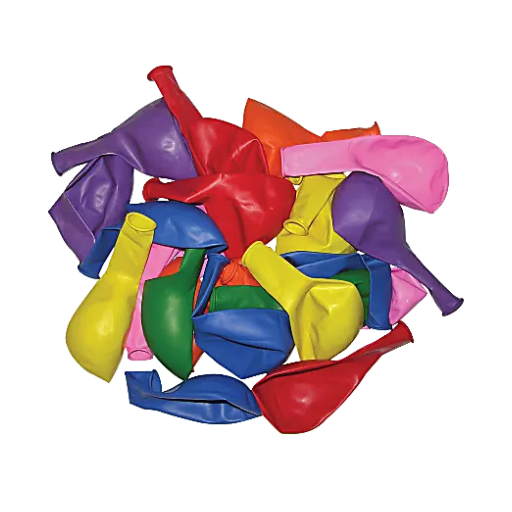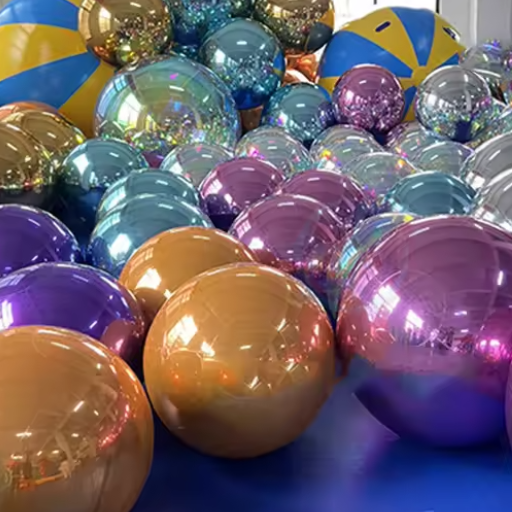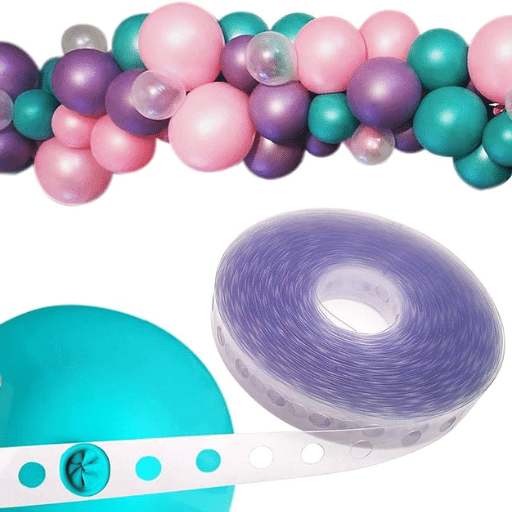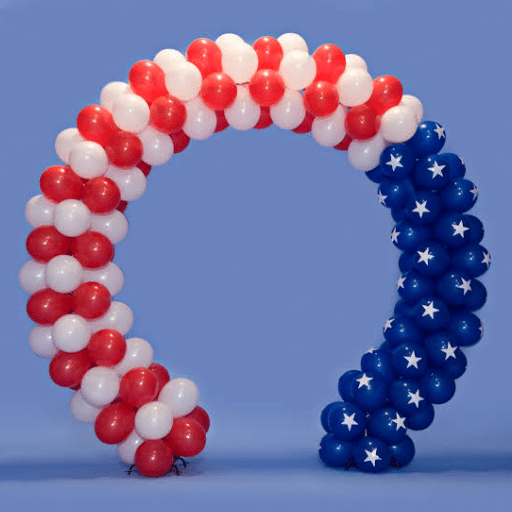Everyone enjoys latex balloons at a wedding reception or a birthday party. While we all love balloons, have you ever wondered how they make these colorful balloons? Balloons are more than just a pretty polymer; they represent the blend of art and alchemy. This blog will take you through the journey of history, latex balloons, their natural and synthetic materials, and the science that challenges the fun world of elasticity, color, and enduring strength. For the curious minds and science lovers, we invite you to follow us on this journey to discover how raw latex is transformed into durable balloons and redefine how you view these festive necessities.
What Materials Are Used to Produce a Latex Balloon?

Latex balloons are mainly made of natural latex, a white sap from rubber trees. This natural resource is famous for its elasticity and environmental friendliness, as it is biodegradable. To improve their properties, the latex is blended with pigments for color and sometimes small amounts of stabilizers and curing agents to enhance strength and durability. All these factors help make balloons that Pops! Withstand the test of time.
Are Latex Balloons Made from Natural or Synthetic Materials?
Latex balloons are made from natural latex, a type of elastic product manufactured from the sap of rubber trees, scientifically known as Hevea brasiliensis. This natural latex is sustainable as it can be renewed when harvested by tapping the trees without causing damage. Unlike synthetic latex, which is made with petroleum compounds, natural latex’s biodegradability is a distinct benefit.
Considering the deflation of synthetic balloons, the balloon-making process starts with curing stabilizers, pigments for bright colors, and other materials. This combination enables balloons to stretch significantly without breaking, fulfilling the requirements needed for celebrations and decorations.
According to new research, natural latex balloons can break down within the same timeframe as an oak leaf, within six months to a year when placed in an appropriate environment. These balloons are significantly more efficient than synthetic ones made with Mylar or nylon, which take decades to degrade. This proves the importance of properly disposed latex balloons.
While latex balloons are predominantly constructed from natural components, some minor synthetic additives enhance performance and usability. The mixture of natural and synthetic components guarantees durability while being less harmful to the environment than fully synthetic options.
How Is Natural Rubber Harvested for Balloon Production?
Natural rubber is harvested from rubber trees (Hevea brasiliensis) through tapping. In this process, minor cuts are made on the tree’s bark to obtain latex, a liquid containing rubber suspended in it. It begins with skilled workers delivering a precise cut into the tree so that the latex will flow smoothly, but does not harm its ability to be tapped over the years. On average, a rubber tree sustains a life of around 25-30 years; therefore, with proper management, it does prove to be a sustainable material.
According to the latest figures, each rubber tree produces around 19 pounds (8.6 kilograms) of latex annually. The collected latex is refined to remove excess substances, undergoes coagulation, and is dried to produce rubber. To ensure that the process of rubber tapping does not disturb the trees and environment around them, modern eco-friendly and sustainable practices have been quite popular among rubber plantations.
Work is also underway to increase harvesting efficiency through agroforestry and other methods, including automated tapping systems. These technologies improve labor elasticity in latex harvesting. The industry’s eco-friendly goals are met since natural rubber harvesting is still renewably sustainable, ensuring that balloon production remains eco-conscious.
The Role of Color and Design in Latex Balloons
| Aspect | Details |
|---|---|
|
Significance of Color |
Evokes emotions and enhances event ambiance |
|
Color Psychology |
Colors influence mood, perception, and behavior |
|
Popular Color Palettes |
Spring (pastels), Summer (bright), Winter (cool) |
|
Customization |
Double stuffing creates unique color combinations |
|
Color Coordination |
Uses complementary or analogous color harmony |
|
Color Schemes |
Match event themes for cohesive aesthetics |
|
Material Types |
Matte, pearl, chrome, and neon latex finishes |
|
Design Versatility |
Shapes, garlands, backdrops, and arches |
|
Eco-Friendly Option |
Biodegradable, sustainable decoration alternative |
|
Ease of Use |
Quick inflation and setup for events |
|
Thematic Appeal |
Designs elevate event themes and styles |
|
Audience Engagement |
Interactive decorations enhance guest experiences |
|
Message Printing |
Custom prints for branding or personal events |
|
Visual Impact |
Creates a vibrant atmosphere with floating designs |
|
Event Adaptability |
Used for weddings, birthdays, corporate events |
Is a Latex Balloon Different from a Plastic Balloon?

Yes, plastic and latex balloons differ in composition. Latex balloons are made from natural rubber extracted from rubber trees, rendering them biodegradable and thus more eco-friendly. In comparison, Plastic balloons are made from non-biodegradable Mylar or nylon, which has a higher environmental impact. Furthermore, Latex balloons are softer and more elastic, while plastic balloons are more durable and retain their shape for a longer period.
Understanding Why Latex Balloons Are Not Plastic
In brief, the answer stems from the composition difference: latex balloons are made of natural rubber harvested from rubber trees and therefore biodegradable, whereas plastic balloons consist of non-biodegradable synthetic materials like Mylar or nylon.
Comparing Latex and Foil Balloons
| Aspect | Latex Balloons | Foil Balloons |
|---|---|---|
|
Material |
Made from natural rubber |
Made from metalized plastic (Mylar) |
|
Cost |
Affordable, ideal for bulk purchases |
Expensive, suited for premium events |
|
Durability |
Prone to popping, shorter lifespan |
Highly durable, lasts up to two weeks |
|
Environmental Impact |
Biodegradable over time |
Non-biodegradable, reusable with care |
|
Design Options |
Limited shapes, wide color variety |
Intricate designs include custom shapes |
|
Helium Retention |
Holds helium for 7-10 hours |
Retains helium for up to two weeks |
|
Event Suitability |
Best for short events, casual decor |
Ideal for formal or themed celebrations |
|
Ease of Use |
Easily inflated, single-use |
Self-sealing, reusable if stored properly |
|
Visual Appeal |
Vibrant, classic charm |
Shiny, elegant finish |
|
Recommended Use |
Budget-friendly decorations for large venues |
Showpiece accents for special occasions |
Environmental Impact of Qualatex Latex Balloons
Qualatex latex balloons have less of an environmental impact than plastic balloons because they are made from 100% natural latex, which is biodegradable. This means that it breaks down in the environment at the same rate as an oak leaf decaying.
Are Rubber Balloons Biodegradable?

Rubber balloons produced from natural latex are indeed biodegradable. They will break down over time due to exposure to oxygen and sunlight, at a pace similar to an oak leaf. However, depending on the environment, this process may take several months.
How Long Do Latex Balloons Take to Decompose in the Environment?
Rubber latex balloons are made of natural rubber, making them biodegradable. However, the time it takes for these balloons to rot changes due to multiple factors. Here is how some of them work:
- Sunlight Exposure: Balloons are exposed to sunlight—specifically UV rays—in daily settings. Research has shown that latex can rot quickly due to exposure to sunlight, meaning rubber balloons would begin decomposing quickly. From what can be seen, the complete decomposition of these latex balloons usually takes a few months, while the initial steps of latex breakdown will occur in weeks.
- Oxygen Concentration: In open spaces, there’s a higher concentration of oxygen available, which proportionately increases the rate of rubber latex balloon breakdown.
- Temperatures: Warmer areas tend to have a higher concentration of bacteria and other microorganisms that would otherwise break down latex rubber balloon molds. These areas speed up balloon rotting, while colder environments tend to slow the decaying process.
- Moisture levels: Like oxygen levels, constant moisture in any area aids in microbial activity. However, these ‘working’ conditions tend to be less common, so it’s safe to say dry wood would be a significantly prolonged scenario for balloons.
- Presence of Microorganisms: Microorganisms are a two-sided sword, as their presence can help provide the materials needed while also canceling themselves out. Rubber balloon molds rely on microorganisms’ activity and would require rich organic materials to rot the latex molds.
Considering the above factors, it has been concluded that rubber latex balloons will take anywhere from 6 months to 4 years to rot completely.
The Chemistry Behind Biodegradable Rubber Balloons
| Aspect | Details |
|---|---|
|
Base Material |
Natural latex from the Hevea brasiliensis tree |
|
Decomposition Process |
Sunlight, oxygen, and microorganisms break down latex into biomass |
|
Environmental Impact |
Reduced plastic waste still poses wildlife risks |
|
Chemical Additives |
Vulcanization agents like sulfur, pigments for color |
|
Breakdown Factors |
UV rays, warmth, and moisture hasten degradation |
|
Decomposition Time |
Months in ideal conditions; slower in natural settings |
|
Biodegradability |
Biodegradable, yet may linger for years under certain conditions |
|
Key Risks |
Harmful if ingested by animals, improper disposal impacts ecosystems |
|
Advantages |
Eco-friendly alternative to synthetic, petroleum-based materials |
|
Limitations |
Requires specific conditions for efficient breakdown |
How Are Balloons Made to Hold Their Shape and Elasticity?

Balloons hold their shape and flexibility because of natural latex (a material harvested from rubber trees). During the manufacturing process, latex is treated with additives like vulcanizing agents that give it strength and elasticity. Using sulfur also enhances the bonds formed between the rubber’s polymer chains during heating, also known as vulcanization, thereby improving stretchability and resilience. Moreover, the balloon surface is coated with a powder or silicone to prevent friction. Combining all these processes allows balloons to retain their form while withstanding air pressure.
The Mixture and Coat Process for Durability
Modern balloons are durable due to a precise mixture of materials and sophisticated coating techniques. While producing latex balloons, specific elasticity and strength-enhancing additives are incorporated alongside environmentally resistant materials. Some key additives used include Emulsifiers to maintain the uniform texture, anti-oxidants for delayed degradation, and pigments for vibrant colors. The formulation undergoes extensive testing to ensure that flexibility and durability are balanced perfectly.
After forming the balloon base, a performance and handling enhancement coat is applied. A recent study states that a thin layer of powdered cornstarch or silicone is often used to cover the premade balloons with a polished and non-tacky finish. This layer guarantees the balloon will inflate correctly and reduces the chances of being torn due to rubbing. Material science advancements have allowed manufacturers to produce latex balloons that endure internal pressures of over seven psi and are less prone to oxidation, drastically improving longevity.
Moreover, modern research emphasizes the development of new biodegradable coatings to help with environmentally friendly concerns. These coatings allow balloons to remain tough while ensuring they decompose after use without harming the environment. Combining strength and sustainability marks a massive improvement in balloon manufacturing.
How Natural Rubber Latex Provides Elasticity
| Aspect | Details |
|---|---|
|
Molecular Structure |
Comprised of cis-1,4-polyisoprene chains |
|
Key Bonds |
Covalent bonds between isoprene chain units |
|
Cross-Linking |
Sulfur forms links between polymer chains |
|
Elasticity Mechanism |
Polymer chains uncoil and recoil when stretched |
|
Thermal Influence |
Heat softens, cooling hardens latex |
|
Recovery Ability |
Returns to original shape after deformation |
|
Strength & Durability |
Enhanced by cross-links and tight chain networks |
|
Energy Dissipation |
Distributes strain through molecular bonds |
|
Flexibility Source |
High molecular weight and cis-polyisoprene units |
|
Processing Impact |
Vulcanization improves elasticity and resilience |
How Do Rubber Balloons Inflate and Hold Helium?

The reason why rubber balloons can be inflated is that natural latex rubber possesses a high degree of elasticity. The gas, air, or helium that is put into the balloon stretches the rubber as much as is possible. The gas will be kept inside the balloon as the rubber expands due to its elasticity. Balloons can float because helium is lighter than air. The tight arrangement of the rubber’s molecules aids in preventing the escape of gas, although, because of helium’s small atomic size, it can escape over time.
The Chemistry of Helium Retention in Balloons
The capacity of a balloon to hold helium varies over time, owing to several chemical and physical factors. Five factors explain how helium is retained.
- Molecular Size of Helium: The size of helium’s atoms is among the smallest known, with a diameter of approximately 0.1 nanometers. Because of their small size, they can diffuse through small gaps or flaws in the latex or rubber material composing the balloon. This results in gradual helium loss.
- Permeability of Rubber Materials: The type of rubber or material used to make the balloon affects helium retention. Latex is a balloon material that consists of a mesh of molecular chains creating a relatively porous structure. This enables the passage of fuel molecules more readily than the synthetic counterparts, like Mylar, whose tighter molecular structures permit reduced flow.
- Effects of Temperature: Gas diffusion takes place with minimum energy; however, varying temperatures will indeed affect the retention of helium. Higher temperatures translate to greater kinetic energy, accelerating the diffusion of helium atoms through the balloon material and hence causing leakage at an increased rate.
- Balloon Thickness: The wall thickness of a balloon also plays a vital role in how quickly the helium escapes. Balloons with thin walls lose helium faster than thicker or multilayered balloons, owing to a lack of a barrier against diffusion. Thicker walls tend to slow down the escape of helium.
- Improving Barrier Coating: Several balloons are coated with polyvinyl alcohol or other polymers, which reduce the surface permeability. These coatings give helium-filled balloons an additional layer that prolongs the floating time by slowing down helium leakage.
In balloon production, understanding the anatomy of a helium balloon, the factors that affect its performance, and the current materials available helps achieve an optimal balance between lightweight structures and improved retention rates.
Why Latex Balloons Are Preferred for Outdoor Events
| Aspect | Reason for Preference |
|---|---|
|
Cost |
Affordable for large-scale outdoor decorations |
|
Environmental Impact |
Biodegradable and eco-friendly material |
|
Durability |
Sturdy in mild weather conditions, lasts several hours |
|
Visual Appeal |
Versatile, vibrant colors enhance outdoor themes |
|
Setup Ease |
Quick to inflate for immediate use |
|
Adaptability |
Works well for shaded or partially shaded areas |
|
Flexibility |
Available in various sizes for different designs |
|
Temporary Use |
Perfect for short-duration outdoor celebrations |
|
Safe Disposal |
Decomposes naturally without long environmental harm |
|
Budget-Friendly |
Ideal for cost-conscious large outdoor events |
References
-
Migration of BTEX and Phthalates from Natural Rubber Latex – PubMed Central
Explores the use of natural rubber latex in various products, including balloons. -
Latex Allergy – StatPearls
Details the latex source from rubber tree sap and its use in products like balloons. -
Marine Debris Program – NOAA
Highlights that latex balloons are made of natural or synthetic latex.
Frequently Asked Questions (FAQ)
Q: What materials are latex balloons made from?
A: Latex balloons are made from natural rubber harvested from rubber trees, specifically the Hevea brasiliensis species. This natural latex is a milky fluid tapped from the tree and then processed to create our balloons.
Q: How are latex balloons different from mylar balloons?
A: While latex balloons are made from natural materials, mylar balloons are made from synthetic polyester film coated with metallic finishes. Mylar balloons are often used for their decorative appeal and strength, as they are more resistant to air loss and punctures.
Q: Are latex balloons sustainable?
A: Latex balloons are considered more sustainable than their synthetic counterparts because they are made of natural materials that are biodegradable when disposed of properly. The latex is harvested from plantations, which can be managed sustainably.
Q: What is the process of making latex balloons?
A: The process begins with collecting the sap from rubber trees, turning it into raw latex, and then dipping molds into the liquid to form the balloon shape. After drying, the balloons are colored, tested for strength and stability, and packaged for sale.
Q: Why do latex balloons come in various colors and sizes?
A: Latex balloons come in various colors and sizes due to the addition of different pigments and the flexibility of the natural latex. This allows them to stretch and expand to various sizes, making them suitable for diverse decor needs and celebrations.
Q: How should latex balloons be disposed of properly?
A: Latex balloons should be disposed of properly by popping them and placing them in the trash. While they are biodegradable, they can take time to decompose, so they should not be released into the environment, as balloon releases can harm wildlife.
Q: Can latex balloons withstand different environmental conditions?
A: Due to their elasticity and strength, latex balloons are quite durable and can withstand a variety of environmental conditions. However, they are not as resistant as Mylar balloons and can degrade faster when exposed to sunlight and heat.
Q: Are latex balloons safe for use at birthday parties and festivals?
A: Yes, latex balloons are safe for use at birthday parties and festivals when they are used and disposed of properly. They provide a colorful and festive atmosphere and are a popular choice for decor at various celebrations.
Q: Is there a difference between natural and synthetic latex in balloons?
A: Yes, there is a difference. Natural latex is derived from the sap of rubber trees, while synthetic latex is made from petrochemicals. Most balloons are made from natural latex, which is considered more environmentally friendly and organic.









